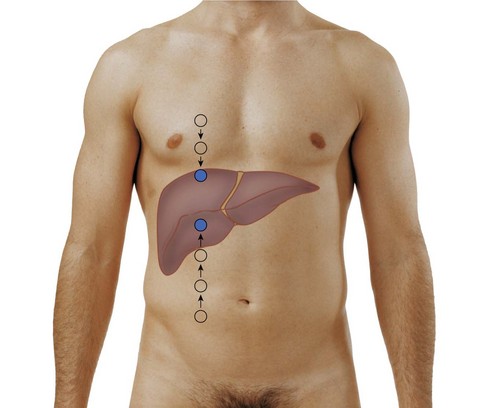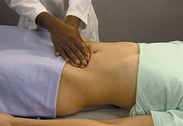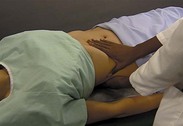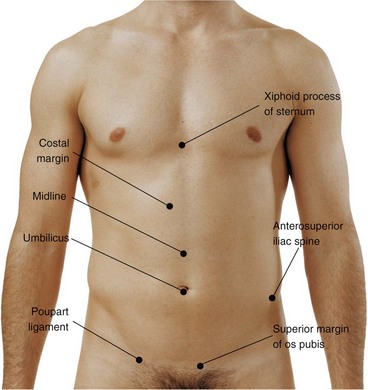EXAMINATION
Have patient in the supine position to start the examination. Approach the patient from the right side.
| TECHNIQUE | FINDINGS |
|---|---|
| Inspect abdomen in all four quadrants (see box on p. 151) | |
 Skin color/characteristics Skin color/characteristics | EXPECTED:Usual color variations, such as paleness or tanning lines. Fine venous network (venous return toward head above umbilicus, toward feet below umbilicus). |
| UNEXPECTED:Generalized color changes, such as jaundice or cyanosis. Glistening taut appearance. Bluish periumbilical discoloration, bruises, other localized discoloration. Striae, lesions or nodules, a pearl-like enlarged umbilical node, scars. | |
| EXPECTED:Flat, rounded, or scaphoid. Contralateral areas symmetric. Maximum height of convexity at umbilicus. Abdomen remains smooth and symmetric while patient holds breath. UNEXPECTED:Umbilicus displaced upward, downward, or laterally or is inflamed, swollen, or bulging. Any distention (symmetric or asymmetric), bulges, or masses while breathing comfortably or holding breath. | |
 Surface motion Surface motion | EXPECTED:Smooth, even motion with respiration. Females mostly costal; males mostly abdominal. Pulsations in upper midline in thin adults. |
| UNEXPECTED:Limited motion with respiration in adult males. Rippling movement (peristalsis) or marked pulsations. | |
Anatomic Correlates of the Four Quadrants of the Abdomen
| Inspect abdominal muscles as patient raises head | |
| EXPECTED:No masses or protrusions. | |
| UNEXPECTED:Masses, protrusion of the umbilicus and other hernia signs, or muscle separation. | |
| Auscultate with stethoscope diaphragm | |
| EXPECTED:Five to 35 irregular clicks and gurgles per minute. Borborygmi, or increased sounds, due to hunger. | |
| UNEXPECTED:Increased sounds unrelated to hunger, high-pitched tinkling sounds, or decreased or absent sounds after 5 minutes of listening (may be associated with abdominal pain and rigidity). | |
 Liver and spleen Liver and spleen | EXPECTED:Silent. |
| UNEXPECTED:Friction rubs. | |
| Auscultate with stethoscope bell | |
| EXPECTED:No bruits, venous hum, or friction rubs. | |
| UNEXPECTED:Bruits in aortic, renal, iliac, or femoral arteries. | |
 Epigastric region and around umbilicus Epigastric region and around umbilicus | EXPECTED:No venous hum. |
| UNEXPECTED:Venous hum. | |
Percussion Notes of the Abdomen
| Note | Description | Location |
|---|---|---|
| Tympany | Musical note of higher pitch than resonance | Over air-filled viscera |
| Hyperresonance | Pitch lies between tympany and resonance | Base of left lung |
| Resonance | Sustained note of moderate pitch | Over lung tissue and sometimes over abdomen |
| Dullness | Short, high-pitched note with little resonance | Over solid organs adjacent to air-filled structures |
Modified from AH Robins Co.
| TECHNIQUE | FINDINGS |
|---|---|
| Percuss abdomen | |
| Note: Percussion can be done independently or concurrently with palpation. | |
| EXPECTED:Tympany predominant. Dullness over organs and solid masses. Dullness in suprapubic area from distended bladder. See table on p. 153 for percussion notes. | |
| UNEXPECTED:Dullness predominant. | |
 Liver span Liver spanTo determine lower liver border, percuss upward at right midclavicular line, as shown in figure below, and mark with a pen where tympany changes to dullness. To determine upper liver border, percuss downward at right midclavicular line from an area of resonance, and mark change to dullness. Measure the distance between marks to estimate vertical span. | EXPECTED:Lower border usually begins at or slightly below costal margin. Upper border usually begins at fifth to seventh intercostal space. Span generally ranges from 6 to 12 cm in adults. |
| UNEXPECTED:Lower liver border more than 2 to 3 cm below costal margin. Upper liver border above the fifth or below the seventh intercostal space. Span less than 6 cm or greater than 12 cm. | |
 | |
| EXPECTED:Small area of dullness from sixth to tenth rib. Tympany before and after deep breath. | |
| UNEXPECTED:Large area of dullness (check for full stomach or feces-filled intestine). Tone change from tympany to dullness with inspiration. | |
| EXPECTED:Tympany of gastric air bubble (lower than intestine tympany). | |
| UNEXPECTED:Dullness. | |
| Lightly palpate abdomen | |
| Stand at patient’s right side. Systematically palpate all quadrants, avoiding areas previously identified as problem spots. With palmar surface of fingers, depress abdominal wall up to 1 cm with light, even circular motion. | EXPECTED:Abdomen smooth with consistent softness. Possible tension from palpating too deeply, cold hands, or ticklishness. |
| UNEXPECTED:Muscular tension or resistance, tenderness, or masses. If resistance is present, place pillow under patient’s knees, and ask patient to breathe slowly through mouth. Feel for relaxation of rectus abdominis muscles on expiration. Continuing tension signals involuntary response to abdominal rigidity. | |
| Palpate abdomen with moderate pressure | |
| Using same hand position as above, palpate all quadrants again, this time with moderate pressure. | EXPECTED:Soft, nontender |
| UNEXPECTED:Tenderness. | |
| Deeply palpate abdomen | |
| With same hand position as above, repeat palpation in all quadrants, pressing deeply and evenly into abdominal wall. Move fingers back and forth over abdominal contents. Use bimanual technique—exerting pressure with top hand and concentrating on sensation with bottom hand, as shown in figure below—if obesity or muscular resistance makes deep palpation difficult. To help determine whether masses are superficial or intraabdominal, have patient lift head from examining table to contract abdominal muscles and obscure intraabdominal masses. | EXPECTED:Possible sensation of abdominal wall sliding back and forth. Possible awareness of borders of rectus abdominis muscles, aorta, and portions of colon. Possible tenderness over cecum, sigmoid colon, and aorta and in midline near xiphoid process. |
| UNEXPECTED:Bulges, masses, tenderness unrelated to deep palpation of cecum, sigmoid colon, aorta, xiphoid process. Note location, size, shape, consistency, tenderness, pulsation, mobility, movement (with respiration) of any masses. | |
 | |
| EXPECTED:Umbilical ring circular and free of irregularities. Umbilicus either slightly inverted or everted. | |
| UNEXPECTED:Bulges, nodules, granulation. Protruding umbilicus. | |
 Liver LiverPlace left hand under patient at eleventh and twelfth ribs, lifting to elevate liver toward abdominal wall. Place right hand on abdomen, fingers extended toward head with tips on right midclavicular line below level of liver dullness, as shown in figure at right. Alternatively, place right hand parallel to right costal margin, as shown in figure at right, below. Press right hand gently but deeply in and up. Ask patient to breathe comfortably a few times and then take a deep breath. Feel for liver edge as diaphragm pushes it down. If palpable, repeat maneuver medially and laterally to costal margin. | EXPECTED:Usually liver is not palpable. If felt, liver edge should be firm, smooth, even. |
| UNEXPECTED:Tenderness, nodules, or irregularity. | |
 | |
 | |
Get Clinical Tree app for offline access 
| |


 Contour/symmetry
Contour/symmetry Frequency and character of bowel sounds
Frequency and character of bowel sounds Vascular sounds
Vascular sounds
 Tone
Tone Spleen
Spleen Stomach
Stomach Umbilical ring and umbilicus
Umbilical ring and umbilicus Gallbladder
Gallbladder

